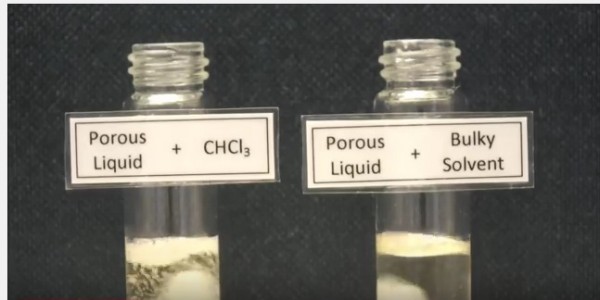Scientists Develop Porous Liquid That Can be Used to Capture and Dissolve Carbon from Atmosphere
| Cybelle Go | | Nov 13, 2015 11:18 AM EST |
(Photo : Youtube Screengrab via Francis Villatoro Channel) A newly develop porous liquid, which has the ability to dissolve carbon dioxide, may be the answer to our environmental problems.
A new scientific breakthrough has been recorded after scientists at Queen's University-Belfast successfully created a porous liquid, according to ChemEurope. The porous liquid has various properties including the ability to capture carbon.
The newly invented liquid can capture enormous amounts of gas, which are eventually dissolved into the 'pores' of the liquid.
Like Us on Facebook
This new substance was discovered by researchers in the School of Chemistry and Chemical Engineering in Queen's University. The team also collaborated with researchers from the University of Liverpool and some international partners.
The development of the porous liquid took almost three years. This achievement is expected to create a path for a more natural chemical process.
Carbon capture, the most viable property of the porous liquid, can potentially trap carbon dioxide from its major sources.
A fossil-fuel power plant may be deemed less harmful the noxious fumes it prodices can be intercepted and dissolved via carbon capture. This will result in a cleaner atmosphere.
"Materials which contain more permanent holes, or pores, are technologically important. They are used for manufacturing a range of products from plastic bottles to petrol," said Stuart James, a Professor in Queen's School of Chemistry and Chemical Engineering.
James added that porous materials have been in the form of solids. He described the process of designing a special liquid from 'bottom up' and also modifying the shapes of the molecules so that the liquid can't take much space.
The Professor noted that since the liquid already possessed holes, it can dissolve unusually huge amounts of gas. The discovery has led to the further exploration of substances that rely on gas dissolution.
"A few years research will be needed, but if we can find applications for these porous liquids they could result in new improved, chemical processes," said James.
©2015 Chinatopix All rights reserved. Do not reproduce without permission
EDITOR'S PICKS
-

Did the Trump administration just announce plans for a trade war with ‘hostile’ China and Russia?
-

US Senate passes Taiwan travel bill slammed by China
-

As Yan Sihong’s family grieves, here are other Chinese students who went missing abroad. Some have never been found
-

Beijing blasts Western critics who ‘smear China’ with the term sharp power
-

China Envoy Seeks to Defuse Tensions With U.S. as a Trade War Brews
-

Singapore's Deputy PM Provides Bitcoin Vote of Confidence Amid China's Blanket Bans
-

China warns investors over risks in overseas virtual currency trading
-

Chinese government most trustworthy: survey
-

Kashima Antlers On Course For Back-To-Back Titles
MOST POPULAR
LATEST NEWS
Zhou Yongkang: China's Former Security Chief Sentenced to Life in Prison

China's former Chief of the Ministry of Public Security, Zhou Yongkang, has been given a life sentence after he was found guilty of abusing his office, bribery and deliberately ... Full Article
TRENDING STORY

China Pork Prices Expected to Stabilize As The Supplies Recover

Elephone P9000 Smartphone is now on Sale on Amazon India

There's a Big Chance Cliffhangers Won't Still Be Resolved When Grey's Anatomy Season 13 Returns

Supreme Court Ruled on Samsung vs Apple Dispute for Patent Infringement

Microsoft Surface Pro 5 Rumors and Release Date: What is the Latest?











